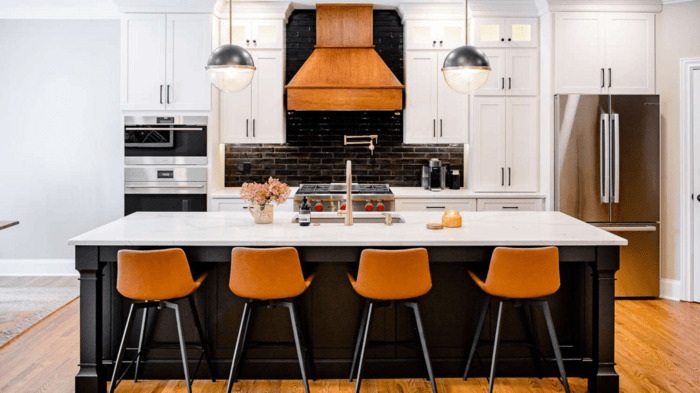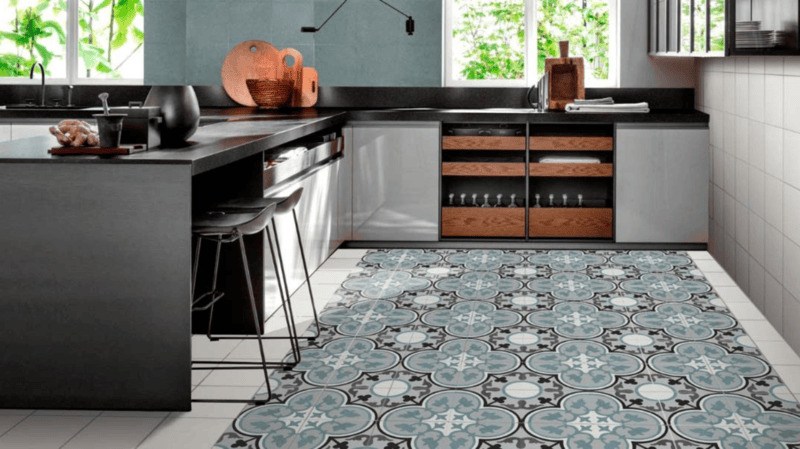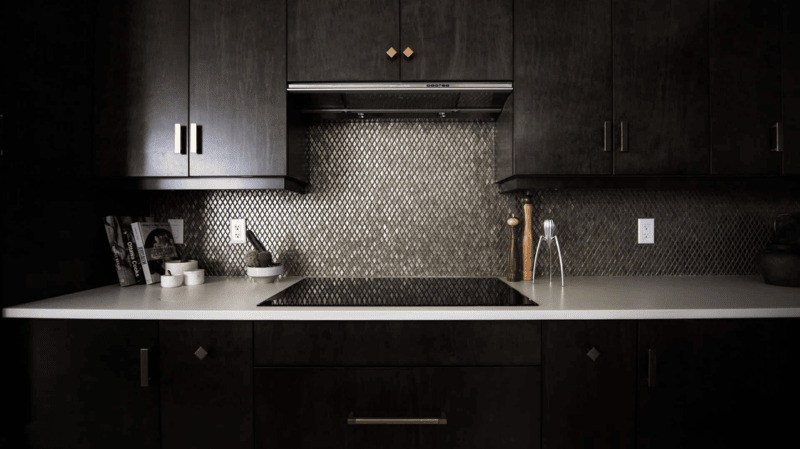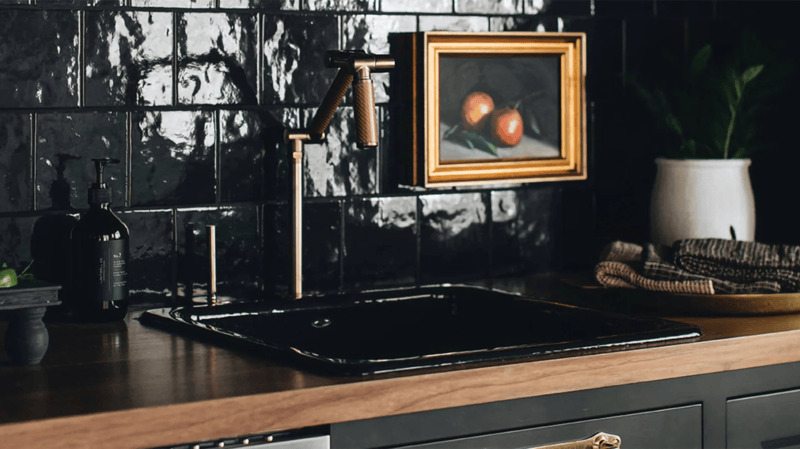Hook: Kitchens have long been the heart of the home, a space where families gather, meals are prepared, and memories are made. As homeowners seek to create inviting and visually stunning kitchen designs, one trend that has gained significant traction in recent years is using a black backsplash.
The choice of a backsplash can profoundly impact a kitchen’s overall aesthetic and functionality. As white kitchens continue to dominate design trends, incorporating a black backsplash has emerged as a captivating contrast that can elevate the space.
Understanding Black Backsplashes

Definition: A backsplash is a protective and decorative panel installed behind a kitchen’s countertop, typically extending from the countertop to the bottom of the upper cabinets. It protects the wall from splashes, stains, and damage while also contributing to the kitchen’s overall design.
Materials Used: Black backsplashes can be crafted from various materials, including tiles (ceramic, porcelain, or natural stone), glass, stainless steel, and chalkboard paint. Each material offers unique aesthetic and practical benefits, allowing homeowners to tailor the look and feel of their kitchen.
Design Trends: The popularity of black backsplashes has surged in recent years as homeowners seek to create a bold and modern look in their kitchens. This trend is particularly prevalent in white kitchens, where the contrast between the light cabinetry and countertops and the dark backsplash creates a striking visual impact.
Aesthetic Appeal of a Black Backsplash

Contrast with White Kitchens: A white kitchen and a black backsplash is a classic and timeless design choice that exudes sophistication and elegance. The stark contrast between the light and dark tones creates a visually stunning focal point, drawing the eye and adding depth to the space.
Visual Depth: A black backsplash can also create the illusion of depth and dimension in a kitchen, making the space more expansive and visually interesting. The dark color can recede, creating the perception of a larger, more open area.
Customization Options: Black backsplashes come in a wide range of designs, textures, and patterns, allowing homeowners to personalize the look and feel of their kitchen. From sleek and modern subway tiles to intricate mosaic patterns, the endless options enable homeowners to find a backsplash that perfectly complements their overall design aesthetic.
Practical Benefits of a Black Backsplash

Ease of Cleaning: One of the practical benefits of a black backsplash is its ability to conceal stains and splatters more effectively than lighter-colored options. The dark hue can mask minor blemishes or discoloration, making the backsplash easier to maintain and keep looking clean.
Durability: Many materials commonly used for black backsplashes, such as tiles and glass, are highly durable and resistant to wear and tear. This makes them an excellent choice for a high-traffic area like the kitchen, where the backsplash is subject to frequent use and potential damage.
Heat Resistance: Certain materials used for black backsplashes, such as natural stone or stainless steel, are also highly heat-resistant, making them a practical choice for areas near the stove or oven. This can help to protect the wall from heat-related damage and discoloration.
Enhancing Property Value of a Black Backsplash

Market Trends: As modern kitchen design continues to evolve, incorporating a black backsplash has become a sought-after feature for many homebuyers. This trend reflects the growing preference for sleek, contemporary kitchens that balance style and functionality.
Buyer Preferences: Potential homebuyers often prioritize a kitchen’s aesthetic appeal and overall condition when evaluating a property. A well-designed kitchen with a striking black backsplash can be a significant selling point, demonstrating the home’s attention to detail and commitment to modern design.
Return on Investment (ROI): The cost of installing a black backsplash can vary depending on the materials used and the project’s complexity. However, the potential increase in property value can often offset the initial investment, making a black backsplash a wise choice for homeowners looking to enhance the value of their home.
Complementary Design Elements of a Black Backsplash

Color Schemes: When incorporating a black backsplash into a white kitchen, it’s important to consider the overall color scheme. Pairing the black backsplash with white cabinetry and countertops creates a classic and timeless look. Still, homeowners can also experiment with other complementary colors, such as gray, wood tones, or even pops of bold hues.
Fixtures and Accessories: The choice of fixtures and accessories can also play a crucial role in enhancing the overall aesthetic of a kitchen with a black backsplash. Sleek, modern faucets, cabinet hardware, and lighting fixtures can reinforce the contemporary feel of the space.
Lighting Considerations: How a black backsplash interacts with the kitchen’s lighting can also significantly impact the overall appearance. Proper lighting, whether recessed, pendant, or under-cabinet lighting, can help accentuate the depth and texture of the backsplash, creating a warm and inviting atmosphere.
Installation Considerations of a Black Backsplash

DIY vs Professional Installation: Homeowners can either tackle the installation of a black backsplash themselves or hire a professional contractor. While a DIY approach can be a cost-effective solution, it’s important to carefully consider the complexity of the project and one’s skill level. Professional installation may be better for those who want a seamless and high-quality finish.
Cost Factors: The cost of installing a black backsplash can vary depending on the materials used, the size of the area to be covered, and whether the homeowner chooses to do it themselves or hire a professional. Factors such as the cost of the materials, labor, and any necessary preparation work can all contribute to the overall expense.
Maintenance Tips: Proper maintenance is key to keeping a black backsplash looking its best. Homeowners should follow the manufacturer’s recommendations for cleaning and care, which may include using mild, non-abrasive cleaners and avoiding harsh chemicals or scrubbing that could damage the surface.
Frequently Asked Questions (FAQs)
What are the best materials for a black backsplash? Some of the most popular materials for black backsplashes include:
- Ceramic or porcelain tiles
- Glass tiles
- Natural stone, such as black granite or soapstone
- Stainless steel
- Chalkboard paint
How does a black backsplash affect kitchen lighting? A black backsplash can significantly impact the lighting in a kitchen. The dark color can absorb light, making the space feel slightly more subdued. However, this can be mitigated using ample overhead lighting, such as recessed or pendant fixtures, and under-cabinet lighting to brighten the work surfaces.
Can I use a black backsplash in a small kitchen? Absolutely! A black backsplash can be an excellent choice for a small kitchen, as it can create the illusion of depth and make the space feel more open and airy. The key is to balance the dark backsplash with light-colored cabinetry and countertops to prevent the space from falling too close.
Recap of Benefits
A black backsplash offers a wealth of benefits for homeowners looking to enhance the aesthetic, functionality, and value of their white kitchens. From its striking visual appeal and practical advantages to its potential for increasing property value, a black backsplash is a design choice that is well worth considering.




